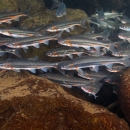Natural resource managers often face hard decisions with uncertain outcomes. Common questions we have encountered include: What is the best way to conserve fish populations in the presence of dams when other threats are also present? or Will removing this migration barrier to benefit native fish let non-native fish invade? In these cases, empirical data may not be available or the question may be very complex or have many potential outcomes. Decision tools, like Bayesian networks, can help in these situations because they help organize thinking and information, provide a transparent record of the logic that led to a decision, and identify the important data gaps that, if filled, would improve future decision making. We have built decision analysis models for a variety of purposes, including predicting habitat suitability under climate change climate change
Climate change includes both global warming driven by human-induced emissions of greenhouse gases and the resulting large-scale shifts in weather patterns. Though there have been previous periods of climatic change, since the mid-20th century humans have had an unprecedented impact on Earth's climate system and caused change on a global scale.
Learn more about climate change , exploring management alternatives for a threatened fish species, and making individual decisions about whether to remove or harden a fish passage fish passage
Fish passage is the ability of fish or other aquatic species to move freely throughout their life to find food, reproduce, and complete their natural migration cycles. Millions of barriers to fish passage across the country are fragmenting habitat and leading to species declines. The U.S. Fish and Wildlife Service's National Fish Passage Program is working to reconnect watersheds to benefit both wildlife and people.
Learn more about fish passage barrier.
Research

